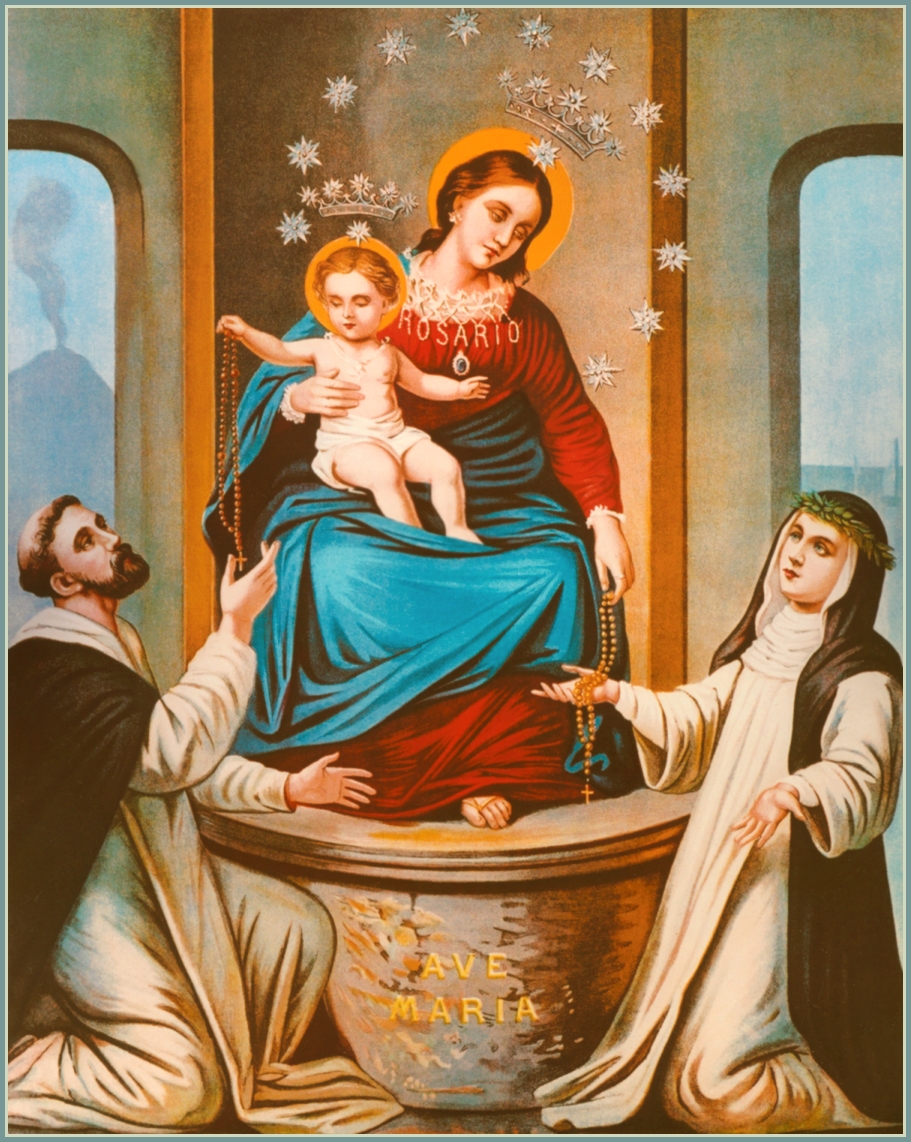Our Lady of the Rosary

Our Lady of the Rosary, also known as Our Lady of the Most Holy Rosary, is a title of the Blessed Virgin Mary in relation to the Rosary. The Feast of Our Lady of the Rosary is on October 7, the anniversary of the decisive victory of the combined Christian fleet in 1571 at the Battle of Lepanto, defeating an Ottoman fleet off western Greece. It was formerly sometimes known as the Feast of Our Lady of Victory.
According to Dominican tradition, in 1206, St. Dominic was in Prouille, France, attempting to convert the Albigensians back to the Catholic faith. The young priest had little success until one day he received a vision of the Blessed Virgin, who gave him the Rosary as a tool against heretics. While Mary’s giving the rosary to St. Dominic is generally acknowledged as a legend, the development of this prayer form owes much to the followers of St. Dominic, including the 15th-century priest and teacher, Alanus de Rupe.
On December 3, 1836, Fr. Charles Eléonor des Genettes had an interior locution directing him to dedicate the parish of Our Lady of Victory to the Immaculate Heart of Mary.
On October 13, 1917, Our Lady of Fatima told the shepherd children, “I am the Lady of the Rosary”.
In 1987, during the civil war with the anti-clerical Sandinista government in Nicaragua, sacristan Bernardo Martinez reported seeing an apparition of Our Lady who urged him to pray the rosary and work for peace. One of the appearances was in the parish church of Our Lady of Victories near Cuapa.
In 1571, Pope St. Pius V organized a coalition of forces from Spain and smaller Christian kingdoms, republics and military orders, to rescue Christian outposts in Cyprus, particularly the Venetian outpost at Famagusta which, however, surrendered after a long siege on August 1 before the Christian forces set sail. On October 7, 1571, the Holy League, a coalition of southern European Catholic maritime states, sailed from Messina, Sicily, and met a powerful Ottoman fleet in the Battle of Lepanto. Knowing that the Christian forces were at a distinct material disadvantage, the holy pontiff, Pope Pius V, called for all of Europe to pray the Rosary for victory,and led a rosary procession in Rome.
After about five hours of fighting on the northern edge of the Gulf of Corinth, off western Greece, the combined navies of the Papal States, Venice and Spain managed to stop the Ottoman navy, slowing the Ottoman advance to the west and denying them access to the Atlantic Ocean and the Americas. If the Ottomans had won then there was a real possibility that an invasion of Italy could have followed so that the Ottoman sultan, already claiming to be emperor of the Romans, would have been in possession of both New and Old Rome. Combined with the unfolding events in Morocco where the Sa’adids successfully spurned the Ottoman advances, it confined Turkish naval power to the eastern Mediterranean. Although the Ottoman Empire was able to build more ships, it never fully recovered from the loss of trained sailors and marines, and was never again the Mediterranean naval power it had become the century before when Constantinople fell.
Pius V then instituted “Our Lady of Victory” as an annual feast to commemorate the victory, which he attributed to the Blessed Virgin Mary.
Dedications to Our Lady of Victory preceded this papal declaration. In particular, Simon de Montfort, 5th Earl of Leicester built the first shrine dedicated to Our Lady of Victory in thanks for the Catholic victory over the Albigensians at the Battle of Muret on September 12, 1213.
In 1573, Pope Gregory XIII changed the title of the “Feast of Our Lady of Victory” to “Feast of the Holy Rosary”.[10] Pope Clement XI extended the feast to the whole of the Latin Rite, inserting it into the General Roman Calendar in 1716, and assigning it to the first Sunday in October. Pope St. Pius X changed the date to October 7 in 1913, as part of his effort to restore celebration of the liturgy of the Sundays. In 1960 Pope John XXIII changed the title to “Feast of Our Lady of the Rosary”.
Our Lady of the Rosary is the patron saint of several places around the world. The diocese of Malaga, Spain (which, however celebrates her patronage on September 8), and the Spanish cities of Melilla and Trujillo celebrate Our Lady of Victories as their patroness. Furthermore, María del Rosario is a common female Spanish name (colloquially abbreviated to Rosario or Charo). Rosario can also be used as a male first name, particularly in Italian.